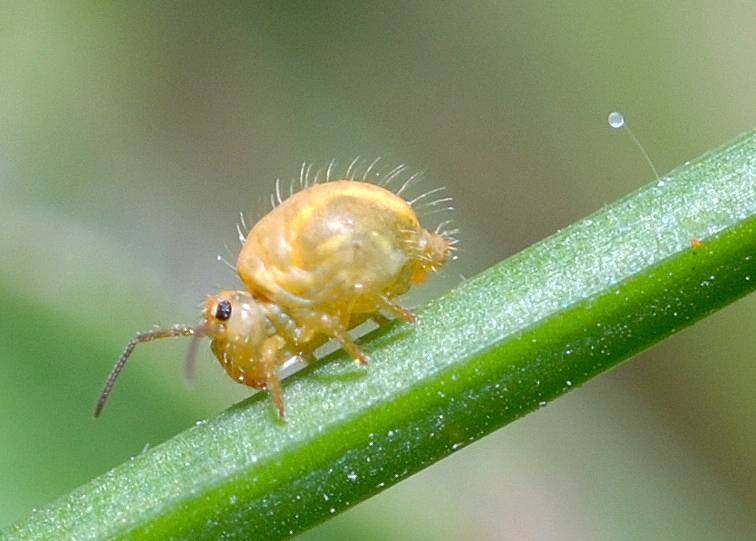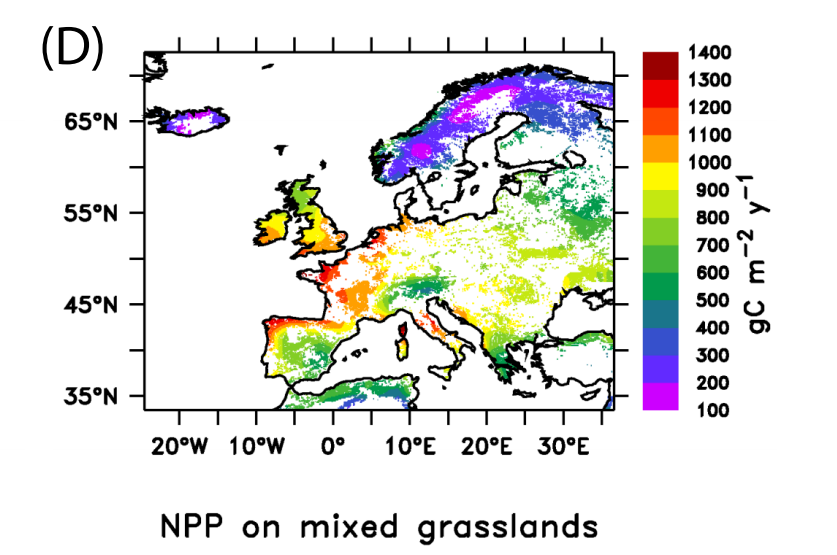Summary
Grassland vegetation feeds many invertebrate herbivores and detritivores, including springtails. I estimate that on a typical grassland, each gram of dry matter of vegetation creates roughly 3 to 6 springtail-years, as well as life for many other invertebrates (mites, earthworms, etc.).
Following is a screenshot from this video to illustrate what one gram of (fairly) dry vegetation looks like (the amount on the scale):

I've also drawn yellow dots on the person's thumb fingernail to illustrate the rough size of 6 springtails. A thumb nail is ~1.5 cm (which I verified on myself), while springtails "are normally about 1 mm long." So I drew the yellow dots to be about 1/15 of the width of the person's thumb. The calculation in this piece finds that the mass of vegetation shown, if it were in a grassland ecosystem, would feed, among other animals, the 6 yellow dots for a year (including replacement dots if these die during the year).
Contents
Introduction
 Grassland plants feed numerous invertebrates, both while the plants are alive (e.g., grasshoppers, leafhoppers, aphids) and once the plants die and decompose (e.g., earthworms, mites, springtails). Springtails are prominent components of the detritivore community. For example, this page says of springtails: "some estimates suggest they are responsible for up to 20% of litter fall decomposition in some places."
Grassland plants feed numerous invertebrates, both while the plants are alive (e.g., grasshoppers, leafhoppers, aphids) and once the plants die and decompose (e.g., earthworms, mites, springtails). Springtails are prominent components of the detritivore community. For example, this page says of springtails: "some estimates suggest they are responsible for up to 20% of litter fall decomposition in some places."
This piece attempts two rough calculations of how many years of springtail life get created by a given dry mass of grassland vegetation. Obviously numerous non-springtail invertebrates are also created by grassland plants, so this calculation is extremely conservative as far as estimating the total number of invertebrates created by grassland primary productivity.
Calculation based on actual springtail densities
This study includes the following map in Fig. 4, showing modeled net primary productivity (NPP) of pastures and hayfields.

The paper says "the grassland process-based ecosystem model PASIM was used to estimate the spatial-temporal distribution of NPP, providing a European average value of 750±150 g C across extensively grazed, intensively grazed pastures, and forage production systems."
This page says:
The carbon content of vegetation is surprisingly constant across a wide variety of tissue types and species. Schlesinger (1991) noted that C content of biomass is almost always found to be between 45 and 50% (by oven-dry mass).
That page recommends using 47.5% as a conversion factor. So, an NPP of 750 g C per m2 per year is roughly 750/0.475 = 1600 g dry matter (DM) of vegetation per m2 per year.
Petersen and Luxton (1982), in a chapter written entirely by Henning Petersen, includes a Fig. 8 (p. 313) that I've copied below:

The height of a bar in this figure represents how many sites or habitats had the measured number of springtails per m2. You can see that most of the measured densities are roughly in the range 104 to 105 individuals per m2. Sites whose ID codes begin with a "G" are temperate grasslands, and codes beginning with "S" are for tropical grasslands (p. 307).
This study also reports that 104 to 105 springtails can be found per m2 of European grassland. Let's be conservative and call this an annual average of 104 springtails (maybe less than this in winter and more in summer?), or roughly 104 springtail-years per year.
Finally, I'll assume that in equilibrium, one year's springtail population on grassland is supported by one year's net primary production. Then, we have
Alternative calculation based on efficiency of converting food to body mass
The estimate in the previous section is probably the most accurate, because the calculation requires only two input numbers that are both relatively well quantified. In the current section I attempt a different estimate using completely different input parameters, to provide a sanity check on the estimate from the previous section. My method in the current section is more complicated and based on more uncertain input parameters than was the case in the previous section, so it's questionable how much value this alternative estimate actually has.
Imagine that we start off with 1 g = 1000 mg DM of grassland vegetation.
This book reports on an experiment in which "42% of the energy captured by ryegrass in the leniently grazed pasture entered the detrital food chain". So let's assume that 420 mg of the 1000 mg of grassland DM are eaten by detritivores.
Petersen and Luxton (1982), in a chapter written entirely by Malcolm Luxton, say on p. 343: "In one year saprophagous animals may consume 20 or 30% of the total annual input of organic matter to the soil (Kitazawa 1967)". I wasn't able to find the Kitazawa study online, and I'm not sure I'm interpreting this number correctly, but let's say that 20% to 30% (average = 25%) of the 420 mg of DM gets eaten by soil animals: (420 mg) * 25% = 105 mg.
Later in the same chapter of Petersen and Luxton (1982), on p. 349, there's a Fig. 34 showing the "Proportions of energy respired annually by the major soil invertebrate groups in selected" soil types, including grasslands. The proportion accounted for by Collembola (i.e., springtails) varies a lot, from almost 0% to around ~1/3 of the total, depending on the site. By eyeballing the figure, I'm guessing that a reasonable average proportion would be between 5% and 10%—let's say 7.5%. Assuming this percentage of respiration is roughly similar to the percentage of dry matter consumed, then we can calculate that (105 mg) * 7.5% = 8 mg of DM is eaten specifically by springtails.
The following figure from p. 49 of Spang (2013) shows ECI values for various animals:

Since I'm doing my calculation in this section using dry weight, the numbers in the "Dry Weight" column seem more useful, although they're for "dressed meat", which means the ECI values for "whole body" would presumably be somewhat higher. The mealworms and crickets mentioned in the table were (sadly) being grown as food, and we would expect that insects chosen for this purpose would have ECIs on the higher end. Moreover, they were fed high-quality diets. For example, the mealworms were fed rolled oats and given carrots "as a source of water" (p. 33). So plausibly springtails in the wild would have somewhat lower ECIs than these insects?
I'll conservatively assume springtails in the wild would have a (whole-body) ECI of, say, 5%. (8 mg of DM eaten by springtails) * 5% = 0.4 mg DM of springtail body mass created.
Petersen and Luxton (1982), in a chapter written entirely by Henning Petersen, contains a Fig. 10 (p. 314) showing that many springtails have body masses in the range of 1 to 10 μg dry weight. I'll err on the conservative side by taking the bigger end of this range: 10 μg. That said, some springtails can be larger than that. This study reports that "The body mass of adult springtails ranges between 0.1 and 0.2 mg (Christian, 1979; Verhoef and Witteveen, 1980)", which is 100 to 200 μg (presumably wet weight? so dry weight might be a few times smaller).
0.4 mg DM of springtails = 400 μg, which is 40 individual springtails at 10 μg each.
Now we need to convert springtails into springtail-years. Springtails may mature into adults in as little as 3-5 weeks. Based on this number, let's assume springtails live, say, 1/12 of a year. Then 40 springtails is 40 * 1/10 = 3 springtail-years created by our initial 1 g DM vegetation. This is surprisingly close to the previous estimate of 6 springtail-years per g DM vegetation.
Most springtails die before adulthood, given that "A female springtail can lay 400 eggs in her lifetime", and on average in a stable population, only two of those offspring can go on to reproduce. So maybe my estimate of 3 to 5 weeks, which is how long it takes springtails to mature, was too long. However, I assumed a per-springtail mass on the higher end of the range, perhaps closer to a typical adult mass? In that case, using an adult lifespan may not be unreasonable. Also, I think springtails sometimes take more than 3 to 5 weeks to mature. For example, this page says: "Springtails [...] can have up to six generations a year", which would imply that it takes at least 2 months to reach maturity.
Estimate per gram of detritus
The above calculations estimate numbers of springtails on a grassland where grass is eaten both by detritivores and herbivores, possibly including large herbivores like cattle. What if the vegetation is instead eaten only by detritivores, such as is the case in a compost bin?
In the previous section I mentioned an estimate that 42% of vegetation is eaten by detritivores. Let's approximate this as basically ~half. So ~half of grassland vegetation is eaten by herbivores and ~half by decomposers like bacteria, fungi, and springtails. Therefore, if we want to estimate springtails per gram of vegetation DM for a compost bin where there are only decomposers and no animals eating live plants, we should ~double the estimates in this piece.